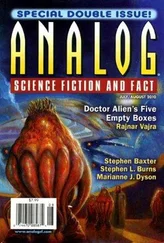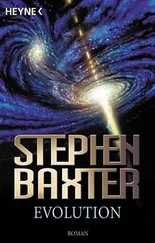Confined for most of his time to the habitats the Gaijin provided, Malenfant was a virtual prisoner. After a time — after years — he knew he was becoming institutionalized, a little stir crazy, too dependent on the small rituals that got him through the day.
He became devoted, obsessively so, to his suit, his shuttle EMU, his one possession. He spent hours repairing it and maintaining it and cleaning it. As much as possible he tried to leave his animated photo of Emma in the space-suit pocket where it had lain for years. He already knew every grain of it, every scrap of motion and sound; he couldn’t bear the thought of wearing it out, of it fading to white blankness; it would be like losing his own existence.
After a time it seemed to him he was getting ill. He sensed he was growing weaker. If he pinched his cheek — or even cut himself — it didn’t seem to hurt the way it should.
It didn’t trouble him, cocooned as he was in the tight confines of his habitats.
He did find out that the Gaijin didn’t suffer such problems.
The very basis of their minds was different. His consciousness was based on quantum-mechanical processes going on in his brain, which was why his whole brain — and his body, his brain’s support system — had to be transported, and was therefore somewhat corrupted by every Saddle Point transition.
Cassiopeia’s “mind” was more like a computer program. It was composed purely of classical information, stuff you could copy and store at will, stuff that didn’t have to be destroyed to be transmitted by the Saddle Points. When she went “through” a gateway, Cassiopeia’s program was simply halted. That way she used up fewer of the Saddle Point link’s stock of entangled states.
He wasn’t enough of a philosopher to say if all this disqualified her from being conscious, from having a soul.
There were other differences.
Periodically he would watch the Gaijin swarming like locusts over the hull of a flower-ship, thousands of them. They would merge, in clattering, glistening sheets, as if melting into each other, and then separate, Gaijin coalescing one by one as if dripping out of a solute.
The purpose of these great dissolved parliaments seemed to be a transfer of information, perhaps the making of decisions. If so it was an efficient system. The Gaijin did not need to talk to each other, as humans did, imperfectly striving to interpret for each other the contents of their minds. They certainly did not need to argue, or persuade; the shared data and interpretations of the merged state were either valid and valuable, or they were not.
But how was it possible to say that this Gaijin, who came out of the cluster, was the same individual as had entered such a merge? Was it meaningful even to pose the question?
To the Gaijin, mind and even identity were fluid, malleable things. To them, identity was something to be copied, broken up, shared, merged; it didn’t matter that the self was lost, it seemed to him, as long as continuity was maintained, so that each of the Gaijin, as currently manifested, could trace their memories back along a complex path to the remote place that had birthed the first of them.
And, likewise, he supposed, they could anticipate an unbounded future, of sentience, if not identity. A cold mechanical immortality.
He was less and less interested in the blizzard of worlds the Gaijin showed him. Even though, as it turned out, everywhere you looked there was life. Life and war and death. He strove to understand what the Gaijin were telling him — what they wanted him to do.
Chapter 14
Dreams of Ancestral Fish
Madeleine Meacher flew into Kourou from Florida.
The plane door slid open, and hot, humid air washed over her. This was East Guiana, a chunk of the northeastern coast of South America. All Madeleine could see, to the horizon, was greenery: an equatorial rain forest; thick, crowding trees; clouds of insects shimmering above mangrove swamps.
Already she felt oppressed by this crowding layer of life, the dense, moist air. In fact she felt a stab of panic at the thought that this big, heavy biosphere was unmanaged. Nobody at the controls. Madeleine guessed she’d spent too long in spacecraft.
Some kind of truck — good grief, it looked like it was running on gasoline — had dragged up a flight of steps to the plane. Madeleine was going to have to walk down herself, she realized. It was the year 2131, and, through the Saddle Points, Madeleine had traveled as far as twenty-seven light-years from Sol. And here, seventy years out of her time, she was walking down airline steps, as if it were 19 31.
Not a good start to my new career, Madeleine thought bleakly.
A man was waiting at the bottom of the steps. He looked about thirty, and he was a head shorter than Madeleine, with crisp black hair and a round face, the skin brown and leathery. He was wearing some kind of toga, white and cool.
She wanted to touch that face, feel its texture.
“Madeleine Meacher?”
“Yes.”
He stuck out his hand. “Ben Roach. I’m on the Triton project here. Welcome to South America’s spaceport.” His accent was complex, multinational, but with an Australian root.
She took his hand. It was broader than hers, the palm pink-pale; his flesh was warm, dry.
They walked toward a beat-up terminal building. There was vegetation here: scrubby, yellowed grass, drooping palms. It was a contrast to the lush blanket she’d glimpsed from the air.
“What happened to the jungle?”
He grinned. “Too many fizzers.” He glanced down, then took her hand again. “Oh. You are hurt.”
There was a deep cut on the index finger; a wound she’d somehow suffered on that creaky old staircase, probably. Madeleine studied the damaged finger, pulling it this way and that as if it were a piece of meat. “It’s my own fault; the plane was so hot I left off my biocomp gloves.” The gloves, like the rest of the bodysuit Madeleine wore, were made of a semisentient mesh of sensors that warned her when she was damaging herself.
“This is the Discontinuity,” Ben said, curious.
“Yeah. Too much teleportation is bad for you.” Eventually, as she played with the finger, she reopened the drying cut.
Ben stared curiously as fresh blood oozed.
Madeleine’s employer had set up an office in the spaceport Technical Center. This housed a run-down mission control center; a press office; a hospitality area; and a dusty, shut-down space museum: tinfoil models of forgotten satellites.
The office itself was cool, light, airy. Too neat. There was rice straw matting on the floor, and scroll paintings on the wall, and flowers. It was all traditional Japanese, though Madeleine could see that the “paintings” were on some kind of softscreen, and so were configurable.
The office had a view of the full-scale Ariane 5 mock-up that stood outside the entrance to the technical center. Sitting on its mobile launch table, the Ariane looked a little like the old American shuttles, with a fat liquid-propelled core booster — called the EPC, for Etage Principal Cryotechnique — flanked by two shorter strap-on solid boosters. The launch table itself was a lot more elegant than the shuttle’s Apollo-era gantries, though; it was a slim, curved tower of concrete and steel, like a piece of modern sculpture, dwarfed by the booster. This mock-up had to be 150 years old, Madeleine figured; its paintwork was eroded away, the old ESA markings barely visible. Mold and creepers clawed at the sides of the rocket — a slow, irreversible vegetable onslaught. The booster was drowned in green, as ancient and meaningless as the ruins of a Mayan temple.
Читать дальше
Конец ознакомительного отрывка
Купить книгу











